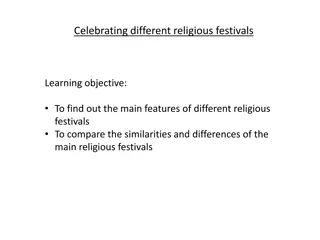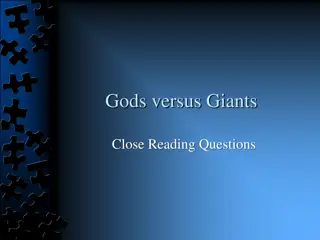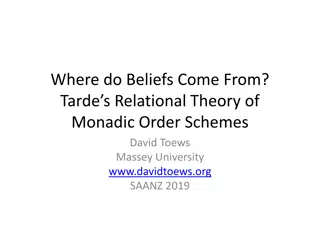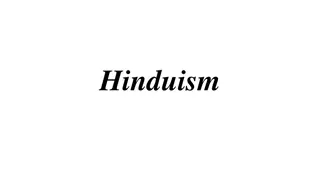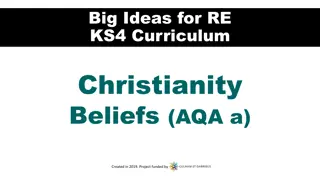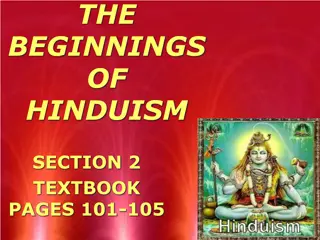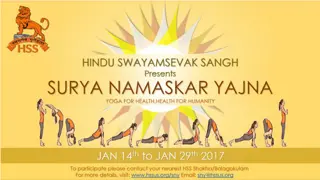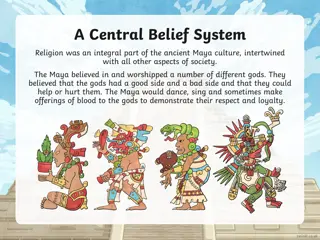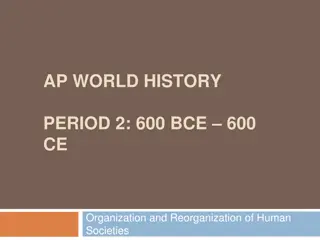Exploring Hinduism: Gods, Beliefs, and Practices
Hinduism, a diverse and ancient religion, encompasses a rich tapestry of beliefs, deities, and spiritual practices. Rooted in the concept of Brahman as the unchanging force in the universe, Hinduism reveres a pantheon of gods like Brahma, Vishnu, and Shiva. The ultimate goal for Hindus is to achieve moksha, liberation from the cycle of rebirth, by understanding the true nature of self and reality. Maya, the illusion that causes suffering, is to be transcended on this spiritual journey.
Download Presentation

Please find below an Image/Link to download the presentation.
The content on the website is provided AS IS for your information and personal use only. It may not be sold, licensed, or shared on other websites without obtaining consent from the author. Download presentation by click this link. If you encounter any issues during the download, it is possible that the publisher has removed the file from their server.
E N D
Presentation Transcript
RELIGIONS OF THE EAST Hinduism and Buddhism
HINDUISM Hinduism has no single founder, no single scripture, no commonly agreed set of teachings, and no known date of origin Hinduism is a way of life Very complex with countless gods and goddesses Major religion of India today
Hinduism Everything in the universe is part of the unchanging, all-powerful spiritual force called Brahman The ABSOLUTE Brahman resides in everything and unites everything in the universe Different gods/goddesses symbolize different aspects of Brahman
Hindu Gods Three main gods of Hindu Brahma the creator Vishnu the preserver Shiva the destroyer The gods can take many forms, human or animal
Brahma This image is protected by digital watermarking - Click here for our free wallpapers. This image is protected by digital watermarking - Click here for our free wallpapers. Brahma
Vishnu Click for a larger image of this Vishnu incarnation Click for a larger image of this Vishnu incarnation Click for a larger image of this Vishnu incarnation Varaha Boar Incarnation of Vishnu Vishnu
Shiva Shiva meditating Shiva Nataraj Shiva
http://www.sanatansociety.org/beeld/gifs/cafepress_chapters_hanuman.gifhttp://www.sanatansociety.org/beeld/gifs/cafepress_chapters_hanuman.gif Ganesha Kali Indra Krishna Dhumavati Kartikay Vamana Sita
Hinduism Hinduism believes that every individual has an essential self or atman Ultimate goal of a Hindu is achieving moksha or union with Brahman Moksha gives a person perfect understanding of all things Must free yourself from selfish desires World known to our senses is called maya this gives people sorrow and pain
Maya Click to see Maya the goddess
Hinduism More than one lifetime required to achieve moksha Believe in reincarnation or the transmigration or rebirth of the soul in another bodily form
Hinduism Get closer to moksha by obeying laws of Karma all actions in a person s life that effect his or her fate in the next life Cycle of rebirth symbolized by the wheel in Indian art Hindu beliefs include the authority of the Vedas most ancient religious texts which define truth for Hindus (passed on orally for hundreds of years before written down)
http://upload.wikimedia.org/wikipedia/commons/thumb/c/c5/Tibetan_chakra.jpg/260px-Tibetan_chakra.jpghttp://upload.wikimedia.org/wikipedia/commons/thumb/c/c5/Tibetan_chakra.jpg/260px-Tibetan_chakra.jpg
Hinduism Hinduism stressed the idea of dharma the religious and moral duties of an individual to escape the wheel of fate--code of conduct Dharma is the natural universal law whose observance allows humans to be contented and happy and avoid degradation and suffering Hindus believe that dharma is the very foundation of life Duties vary according to caste obey and acquire merit in next life
VEDAS Vedas include hymns of praise to God, rituals and prayers to guide the priests in their duties (eventually written down in Sanskrit) They concern worship and meditation Rig-Veda (1028 hymns) are the oldest of the Vedas Important texts include the Upanishads (central concept is Brahman), Bhagavad Gita (obedience and duty) which is part of the Mahabharata (greatest epic poem of India) and Ramayana (good overcoming evil)
Jainism Mahavira, a Hindu teacher founded Jainism Jainism is a religion that emphasizes complete non-violence and asceticism Incorporates the traditional Hindu concepts of karma, reincarnation but rejects the Veda scriptures, castes and the idea of a creator god Goal of life is to reach liberation by a life of purification and discipline
JAINISM Five Great Vows 1) non-violence 2) Truth 3) non-stealing 4) celibacy 5) non-possessiveness Monks and nuns do not eat when it is dark or in front of a layperson They do not except food that is cooked for them They do not wear shoes or stay in one place for a prolonged period of time
JAINISM Do not touch the opposite sex They wear single white clothes or nothing at all Do not create art or get involved in social matters Monks expected to be homeless, shave their heads and beg for food
JAINISM Must be vegetarians or fruitarians (eat only fruit, nuts and milk) During meditation they chant mantras All life is sacred even the smallest insect Death by starvation is the ultimate for Jains
Hinduism Hindus commonly practice yoga the physical and mental discipline harmonizing the body with the soul In Hinduism the cow is revered as the source of food and the symbol of life should never be killed
MAURYAN EMPIRE Empire divided into provinces which were ruled by governors appointed by ruler subdivided into districts Trade flourished capital city rivaled even the great Persian cities Chandragupta converted to Jainism in later life Abdicated after 25 year reign ascetic who self-starved
MAURYAN EMPIRE Asoka was the third emperor of the Mauryan dynasty reign of virtue Considered ancient India s greatest ruler and one of the greatest men in history In the history of Buddhism he ranks second only to Buddha His coronation was in the year 269 B.C.E. 8 years into his reign he annexed Kalinga
ASOKAS RULE At the bloody battle his army killed over 100,000 people and took 150,000 captives Only aggressive war of his reign (believed to have converted to Buddhism two years prior) Four years later he publicly issued edicts proclaiming his profound sorrow and remorse for his actions Devoted the rest of his life to non-violence gave up hunting, royal luxuries and the use of meat in royal kitchens
ASOKAS RULE Established and endowed hospitals for men and animals banyan trees planted on highways for shade, mango trees were laid to provide fruit, wells were dug, watering places constructed and rest houses established Declared all his subjects as his children urged subjects to practice non-violence and non- injury toward fellowmen and animals; revere parents, teachers, mendicants and elders
ASOKAS RULE Be kind to inferiors such as servants, serfs, and beasts of burden; be truthful and respect beliefs of others (protection of all religions) Cruelty to domestic and wild animals was prohibited
ASOKAS RULE Recorded ethical doctrines by inscribing them on rocks, sandstone pillars, and cave walls (Rock Edicts and Pillar Edicts) Sent out missionaries to spread Buddhism Built over 8,000 temples and 1,000 stupas or tombs in honor of the Buddha
ASOKAS RULE Central regions of empire governed directly from capital while outlying domains were divided among four viceroys Council of ministers advised the king Proclaimed a non-expansionist policy and urged peaceful co-existence
GUPTA EMPIRE Known as India s Golden Age The Kushan Empire had collapsed and Chandra Gupta I united most of northern India Great period of intellectual advancement Literature and art flourished during this period In mathematics the Indian numeral system (commonly known as Arabic numerals) was developed first to develop concept of zero
GUPTA EMPIRE Developed decimal system based on ten In astronomy Indian scholars said the earth is round and rotated on it s own axis In medicine developed techniques for plastic surgery Indian physicians excelled at caesarean sections, bone setting, and skin grafting
GUPTA EMPIRE In literature great works were written in Sanskrit including fables and folk tales that inspired many Islamic literary works (Ali Baba and Forty Thieves and Aladdin and His Magic Lamp) The Karma Sutra written which is considered the standard work on human sexual behavior The game of chess was believed to have been developed during this period
GUPTA EMPIRE Government was highly decentralized unlike the Mauryan government King at top of hierarchy entire territory divided into provinces with a Viceroy overseeing region Villages controlled by headman with a council of elders a lot of discretion given to viceroy Gupta empire declined due to weak rulers and invasions
INDIAN CIVILIZATION Contributions also include rust-free iron
Buddhism Arose in India Founded by Siddharta Gautama Great Renunciation gave up all his worldly possessions to search out questions Why does suffering exist? What is the value of life and death? Became the Enlightened One or Buddha
Buddha images of several sizes. Chiang Mai, Thailand (color) Classic sitting Buddha image. Sukothai, Thailand (color) Amida seated on a lotus flower, the largest Buddha statue carved in over 900 years, Byodo-In Temple. Oahu island, Hawaii, USA (color) Buddha photo Plate6aa.jpg (2902 bytes)
Buddhism Developed the idea of the Four Noble Truths 1) life is full of suffering, pain and sorrow 2) cause of suffering is desire for material things 3) cure suffering by overcoming desire 4) overcome desire by following the Eightfold Path
Eightfold Path Right view Right intention Right speech Right action Right livelihood Right effort Right mindfulness Right concentration Key to success is the Middle Way Moderation in all things Eightfold Path is a way of life between life devoted to pleasure and one based on harsh self-denial Unselfishness is the key
Buddhism Honesty, charity and kindness to all living things Avoid evil words and actions Ultimate goal is to achieve nirvana or union with the universe and release from the cycle of rebirth brings perfect peace
Comparison between Hinduism and Buddhism Both accept the law of Karma, dharma, reincarnation and non- violence Buddhism rejected Hinduism s priesthood, formal rituals, existence of many gods and caste system
Buddhism Both men and women became followers of Buddhism Complete equality of all believers Live in monasteries and convents Sacred text is Three Baskets of Wisdom
Schools of Buddhism Theravada Buddhism Closely follows original teachings Devote yourself to hard spiritual work Mahayana Buddhism Views Buddha as a god
Confucianism Founded by Confucius (Kung Fu Zi) China s most influential philosopher/scholar Believed that a good society was one that preserved peace and order among individuals and between the people and their government
Confucianism Sayings compiled in The Analects Concerned with worldly goals to ensure social order and good government Grew up during period of civil war in China Chinese civil service exam based on Confucian teachings Chinese government based on Confucian ideas
Basic Relationships Father to son Unequal Elder brother to younger brother Unequal Husband to wife Unequal Ruler to subject Unequal Friend to friend equal
Older people superior to younger people Men superior to women Mother s of sons should be respected Everyone in the relationships had duties and responsibilities Correct behavior brings order and stability Woman s duty to ensure stability of family and promote harmony in the home
Confucianism Taught filial piety respect for one s parents and elders above all other duties Values of honesty, hard work, reverence to ancestors and concern for others



